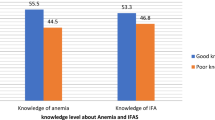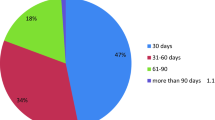Abstract
Objective: Intervention with iron supplementation, deworming, and information, education and communication (IEC) to improve the haematological status among each of the three trimesters of pregnant women in a rural community.
Design: A community-based study was carried out using a two-group pre–post experimental design in a rural community.
Setting: Two rural blocks in Vellore district were selected for the study. KV Kuppam block with a population of 120, 000 and the adjacent Gudiyatham block with a population of 132, 000 served as study and control areas for the study.
Subjects: Using a multistage sampling, initially 50% of the panchayats, the local village administrative units, were randomly selected and all pregnant women were the subjects. In the pre-intervention survey 458 and 387 pregnant women had haemoglobin tested and the post-intervention survey covered 403 and 425 pregnant women in the study and control areas, respectively. Similarly serum ferritin was tested in a randomly selected sub-sample with 254 and 191 pregnant women before intervention and in 216 and 223 pregnant women after intervention in both study and control areas, respectively.
Intervention: Iron supplementation and deworming were provided to all pregnant women in the study area from the fourth month of their pregnancy. An intensive information, education and communication was carried out with facts on anaemia and diet modification to each pregnant woman, using a one-to-one approach in the community, and a group method in the mobile clinics. This was carried out for a period of 18 months.
Results: A significant decrease in the prevalence of anaemia was found, from 56.1% to 25.07% (P<0.001), 73.4% to 49.2% (P<0.001) and 68.8% to 56.8% (P<0.01) among women in the first, second and third trimesters, respectively, in the intervention area. Significant (P<0.001) increases in the mean haemoglobin of 0.85 g/dl (95% CI 10.18–10.84, 11.09–11.63), 0.59 g/dl (95% CI 9.98–10.34, 10.55–10.95) and 0.36 g/dl (95% CI 9.93–10.33, 10.25–10.73) were also observed in each of the groups.
Conclusion: A comprehensive community-based intervention with iron supplementation, helminthic treatment and increase in knowledge using IEC through effective strategies can improve the haematological status of pregnant women in each trimester.
Sponsorship: Mother Care Project, John Snow Inc., Funded by the United States Agency for International Development (USAID).
European Journal of Clinical Nutrition (2000) 54, 490–493
This is a preview of subscription content, access via your institution
Access options
Subscribe to this journal
Receive 12 print issues and online access
$259.00 per year
only $21.58 per issue
Buy this article
- Purchase on Springer Link
- Instant access to full article PDF
Prices may be subject to local taxes which are calculated during checkout
Similar content being viewed by others
Author information
Authors and Affiliations
Contributions
Guarantors: R Abel and J Rajaratnam.
Contributors: RA was the investigator. JR was the coinvestigator. AK and SK were implementors.
Additional information
This publication was made possible through support provided by the Office of Health and Nutrition, United States Agency for International Development (USAID), under the terms of contract no. HRN-C-00-9300038-00 and John Snow Incorporated (JSI). The contents and opinions expressed herein are those of the authors and do not necessarily reflect the views of USAID and JSI.
Rights and permissions
About this article
Cite this article
Abel, R., Rajaratnam, J., Kalaimani, A. et al. Can iron status be improved in each of the three trimesters? A community-based study. Eur J Clin Nutr 54, 490–493 (2000). https://doi.org/10.1038/sj.ejcn.1601044
Received:
Revised:
Accepted:
Published:
Issue Date:
DOI: https://doi.org/10.1038/sj.ejcn.1601044
Keywords
This article is cited by
-
Effects of deworming on child and maternal health: a literature review and meta-analysis
BMC Public Health (2017)
-
Micronutrient status in lactating mothers before and after introduction of fortified flour: cross-sectional surveys in Maela refugee camp
European Journal of Nutrition (2012)
-
Prenatal iron supplementation in rural Vietnam
European Journal of Clinical Nutrition (2008)
-
Should Deworming Be Included in Antenatal Packages in Hookworm-endemic Areas of Developing Countries?
Canadian Journal of Public Health (2006)
-
Prevalence of multiple micronutrient deficiencies amongst pregnant women in a rural area of Haryana
The Indian Journal of Pediatrics (2004)



